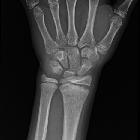Turner Handgelenk








Gymnast wrist is a term that is used to describe a variety of chronic overuse injuries of the wrist in gymnasts with an immature skeleton. Gymnast wrist comprises a combination of osseous and ligamentous injuries and usually manifests as a chronic Salter-Harris type I fracture of the distal radial physis on radiography .
Epidemiology
Distal radial physeal injury is common in gymnasts, and occasionally occurs in other sports . The distal radius is mostly involved because it bears the primary stressful forces in the wrist joint .
Clinical presentation
Pain with gradual onset and exaggeration by weight-bearing activities while the wrist in extension position. Often, range of motion is normal on physical examination, and frequently swelling and tenderness over the distal radius presents .
Pathology
Gymnast wrist results from repetitive compressive forces applied to the distal radial physeal plate during participation in sports like gymnastics and weight-lifting that place a great tension on the physis and adjacent structures .
Radiographic features
- physeal plate widening
- physeal plate irregularity
- metaphyseal and less commonly epiphyseal sclerosis and irregularity
- physeal plate bridging/fusion in late stage of the disease
Plain radiograph
Most of the above-mentioned physeal, metaphyseal and epiphyseal changes are usually evident on radiography .
MRI
MRI may be used when radiographs are inconclusive. MRI can demonstrate the greater detail about the physeal cartilage and edema in the adjacent bones before these changes become visible on radiographs .
It is worth mentioning that MRI is crucial in high-risk patients with chronic wrist pain because early detection is essential in preventing further damage to the distal radial physis .
Treatment and prognosis
As with similar injuries, the mainstay of treatment is rest with ice packs and anti-inflammatory agents as required.
The prognosis is dependent on the stage of the injury and radiographic findings at the time of diagnosis, with splint/cast immobilization, recovery may take anywhere from one to six months .
Complications
Complications of untreated fracture include:
early physeal closure of the distal radius leading to positive ulnar variance and Madelung-type deformity in cases that lack proper treatment or experience a prolonged healing process
Siehe auch:

 Assoziationen und Differentialdiagnosen zu Turner Handgelenk:
Assoziationen und Differentialdiagnosen zu Turner Handgelenk:
